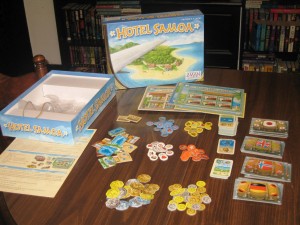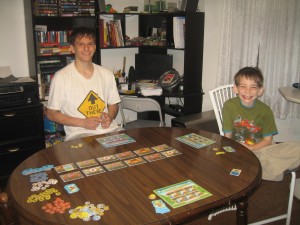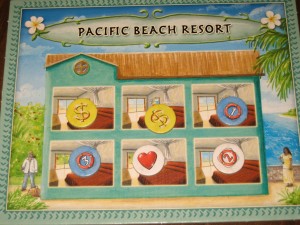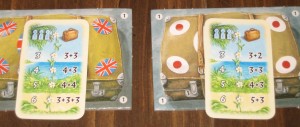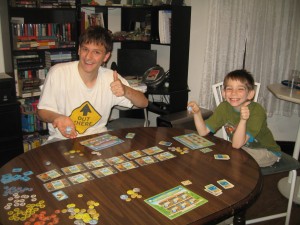Tycoon games are probably my favorite games to play, mainly because I have a crippling need to control everything. I can’t tell you how many times I’ve obsessed over my theme park in Roller Coaster Tycoon. I would sit there for hours changing colors, making the prices just right…it got so bad that even the park guests began waving at me as if to remind me to take a shower. Hotel Samoa reminds me a little of Hotel Giant, another tycoon game, but dumbed down and simplified to make for a quick fix on family game night.
In Hotel Samoa, players will be trying to place tourists of varying nationalities into their hotel in such a way that makes them the most money. Let’s go over the components and rules briefly before heading into the review. If you are interested in learning more about Hotel Samoa, the manual can be found online here:
Components
Hotel Boards – Each player receives a board that features six rooms where the tourists can stay.
Flags – There are twelve cardboard flags, three of each nationality and are used in each of the twelve rounds of the game.
Tourist Cards – These thirteen tourist cards tell players how many tourists arrive in each round. These cards also describe in what grouping said tourists arrive. (Three tourists in group one, two tourists in group two, etc.)
Price Cards – There are six sets of eleven cards, one for each player, and are used to bid on build tiles as well as set the price for prospective tourists. Each card has two ends, one that lists a build bid and one that lists a price.
Tourist Chips – There are eighteen chips of each nationality, drawn at random when tourist cards are revealed in each round. Players will be choosing from these tourist chips and possibly place them into their hotel.
Build Tiles – Build tiles are bid on by players and improve your hotel in various ways. Some add extra rooms while others turn your existing rooms into suites.
2X Tiles – These are placed on the sixth and twelfth flag. During the sixth and twelfth round, double tourists arrive on the island.
Tie Breaker Card – This card revolves around the board every round and is placed between two players. One end of the card gives players going clockwise priority during ties regarding build tiles, while the other end gives players going counter clockwise priority during ties regarding prices in the tourist phase.
Setup & Gameplay
Each player gets a hotel board, coins valued at “25”, and a set of price cards. The twelve flags are arranged in a line horizontally in such a way where the nationalities are a good distance from each other. The 2X tiles get placed on the sixth and twelfth flag. The tourist cards and build tiles are shuffled separately and the tie breaker card is placed between two random players.
The game starts with round one, utilizing the leftmost flag. In a round, there are six phases:
1) Reveal build tile(s) – The number of build tiles drawn at random depends on the number of people playing.
2) Tourist arrival / departure – Existing tourists of the nationality shown on the flag go home and new tourists of that same nationality arrive.
3) Select and reveal price cards – Players select one card from their hand and place it face down, revealing them all at once.
4) Build phase – The player with the highest build bid on their card gets to buy any build tile available for the price listed on the card. Then, the player with the second highest build bid gets to buy one, and so on. Players may pass if they wish. Ties are resolved via the tie breaker card.
5) Tourist phase – The player with the lowest price on their card gets to select tourists from one of the available groups and places them in their hotel. Then, the player with the second lowest price gets to pick from the remaining tourists / groups, and so on.
6) Payment and card discard – Whoever brought new tourists into their hotel get paid. Tourists pay the amount shown on the price section of the card that each individual player played. If anyone accommodated tourists or bought a build tile, the card they played is discarded. Otherwise, they keep the card. Players always keep the staff holiday card, which simply allows the player to remove two guests from their hotel without the chance to build or accommodate new tourists. The tie breaker card also moves clockwise between the next set of players.
Certain tourists pay out bonuses which will affect your strategy and placement. Anyone who moves into a room next to a celebrity, for example, pays double the price. You can read more about the finer details by following the link above.
Whoever has the most money after twelve rounds is the winner.
The Review
I appreciate what this game does, even if it isn’t as deep as I would have liked it to be. One thing that I was disappointed to see was that the effects of bonuses weren’t cumulative. I would imagine that this is to address balance issues, but this also discouraged me from finding the perfect hotel setup. As long as players keep in mind that this is a light “hotel management” game, they would probably find it to be enjoyable.
While I consider the game light, that is not to say that there isn’t some strategy involved. Every round, you are forced to make a decision on whether or not you want to pass during the build and tourist phases. Being the first to bring in tourists on the first few turns by using very low price cards might fill your hotel, but might allow others to bring in tourists at a higher price because they have no competition (a player with a full hotel cannot accommodate new tourists). There is also the matter of using money, the very thing you need to win the game, to purchase build tiles. Players will be constantly asking themselves if they think the risk is worth it.
Vinnie Jr, the eleven year old, said that he enjoyed the strategy when placing tourists in the hotel. I could tell he was giving some thought on where to place them. He bought two swimming pools, so he was regularly looking to bring in tourists with the buoy icons for bonus points.
Anthony Jr, the sixteen year old, was on the fence. He liked the overall idea that the game was trying to convey, but often brought too many tourists in to where he’d be forced to play the staff holiday card to get rid of some. I then capitalized on this by playing a high price card as my only other competition was Vinnie. Anthony wished that the hotels were bigger and the game longer, as well as wanting more ways to get rid of tourists quicker.
Our game lasted about fifty minutes and it was a close game all the way through. I won at 170, Anthony at 163, and Vinnie at 160. We all were able to make great moves throughout the game that boosted our money by a large amount, so the ability to come back from losing is very doable.
Overall, I found the game to be a good filler for when we’re tired of playing our usual favorites. It’s fairly light and somewhat easy to moderate to play, so it works well for when my headache doesn’t allow for games like Agricola or Cosmic Encounter. I recommend reading the manual and giving the game some further research if any of the above sounds intriguing to you.
Final Verdict: 7/10

